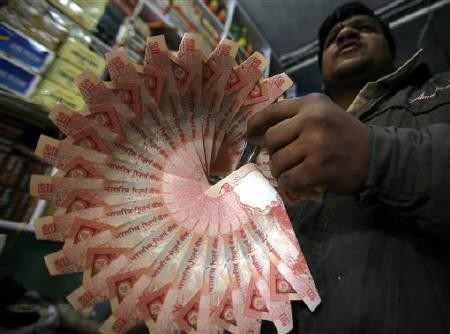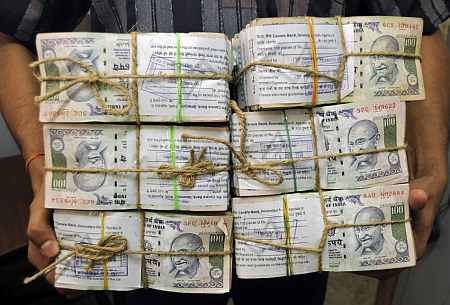 | « Back to article | Print this article |
Rupee fall to hit India Inc's margins by Rs 11k cr
The rupee's depreciation of 9.36 per cent against the dollar in the first quarter of the current financial year is expected to increase India Inc's mark-to-market (MTM) losses on foreign currency loans by over Rs 11,000 crore (Rs 110 billion) in April-June.
Adding to the MTM losses, Rs 17,810-crore (Rs 17.81 billion) foreign currency convertible bonds are outstanding for redemptions in 2012-13.
Embedded redemption premium and 36 per cent depreciation during the past five years will realise forex losses worth Rs 6,720 crore (Rs 67.2 billion) in 2013, according to a study by Edelweiss Research.
Click NEXT to read more...
Rupee fall to hit India Inc's margins by Rs 11k cr
In the year ended March 2012, when the rupee had depreciated from 44.59 to 50.88, a fall of 14.11 per cent, 162 listed companies had made a provision of Rs 14,976 crore (Rs 149.76 billion) in their profit and loss (P&L) accounts for losses on foreign currency fluctuations.
"Payment towards interest payable during the year and any repayment of principal will have to be provided to P&L during the year," said Venkatraman Vishwanath, partner, accounting advisory services at KPMG India.
The real impact of the rupee's depreciation could be much higher if all companies provide for MTM losses on long-term external commercial borrowings (ECBs) and foreign currency bonds.
Click NEXT to read more...
Rupee fall to hit India Inc's margins by Rs 11k cr
The balance sheet data culled from Capitaline-Plus revealed that 270 listed companies have had foreign currency loans worth Rs 300,000 crore (Rs 3,000 billion), and a 9.35 per cent depreciation in the rupee alone could increase the MTM provisioning by around 30,000 crore (Rs 300 billion).
Options available with companies on accounting of forex exposure:
If a foreign currency borrowing is raised to fund the construction of a qualifying asset -- such as the construction of a factory or setting up of a new plant, which takes substantial time to complete -- it may be possible for a company to capitalise both interest costs and foreign currency fluctuations under the current accounting rule under AS 11 and 16.
Click NEXT to read more...
Rupee fall to hit India Inc's margins by Rs 11k cr
For short-term foreign currency borrowings (not greater than one year), interest and foreign currency fluctuation costs will normally be recognised in the profit and loss account.
For long-term foreign currency borrowings (not used for the construction of qualifying assets), while it may be possible to defer the immediate impact of foreign currency fluctuations on the principal amounts, interest costs (and FX fluctuations on interest amounts) would continue to be recognised in the profit and loss account.
Derivatives accounted for under AS 1 will require provisions for unrealised mark-to-market losses with unrealised gains being ignored.
Click NEXT to read more...
Rupee fall to hit India Inc's margins by Rs 11k cr
Mark-to-market amounts (both gains and losses) relating to derivatives accounted for qualifying cash flow hedges under AS 30, to the extent they are effective hedges, be recognised in reserves (the cash flow hedge reserve) and only be reclassified to the profit and loss account when the hedged item, such as a forecasted purchase or sales transaction impacts earnings.
However, pursuant to the Companies (Accounting Standards) Amendment Rules, dated December 29, 2011, the companies are adjusting foreign exchange losses on long-term foreign currency loans in balance sheet till the applicable loan period.
The government has extended the applicability of the rules to up to March 31, 2020. Accordingly, the companies are exercising the option and adjusting exchange gain/loss to the balance sheet.
Click NEXT to read more...
Rupee fall to hit India Inc's margins by Rs 11k cr
For example, Reliance Communications Ltd, part of the Anil Ambani-led Reliance Group, for the year ended on March 2012, added Rs 1,749 crore (Rs 17.49 billion) of exchange differences on long-term borrowing to the cost of capitalised assets.
Further, the company has accumulated foreign currency variation of Rs 470 crore (Rs 4.7 billion) on other long-term foreign currency monetary items, which are to be amortised over balance period of loans.
Though companies can amortise the losses on loans due to currency fluctuations over the balance period of loans, the realised interest on foreign currency borrowing has to be accounted in the P&L account.
Click NEXT to read more...
Rupee fall to hit India Inc's margins by Rs 11k cr
The Mukesh Ambani-led Reliance Industries Ltd has provided Rs 683 crore (Rs 6.83 billion) as finance cost and applicable loss on foreign currency transactions and translation.
Going forward, the rupee is likely to appreciate from the current levels, which could bring some relief to the companies having forex exposure.
According to Goldman Sachs, India's current account deficit seems to have peaked. The banking giant's global economic research report on India's capital account says: "We remain positive on Indian rupee on medium-term bases and for the next three months, Indian rupee may trade around Rs 53 a dollar."
Click NEXT to read more...
Rupee fall to hit India Inc's margins by Rs 11k cr
Japan's Nomura said in its report Indian rupee would appreciate from here and by December the rupee could reach 54.6 per dollar.
It is also s fact that borrowing money from overseas market is no more cheaper. Naresh Takkar, managing director of rating agency ICRA, said:
"With volatility in the currency markets and increase in credit spreads due to risk averseness, the incremental cost of such funds on a fully hedged basis are comparable or actually higher than borrowing from domestic market."








